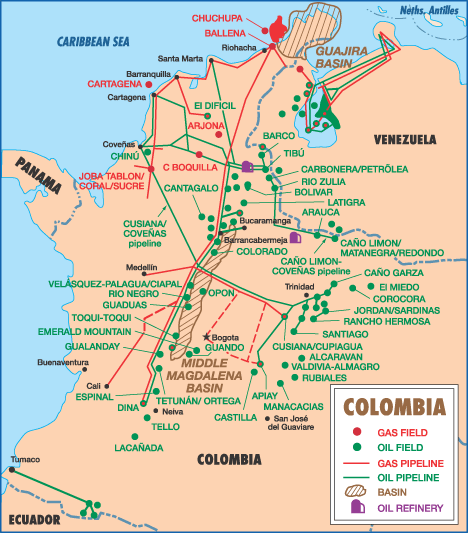|
Aug.
2001 Vol. 222 No. 8
International Outlook
|
SOUTH AMERICA
Stuart Wilkinson, Contributing Editor
Colombia
Economic growth should improve to 3.8% this year, after
only 2.8% in 2000. Inflation should drop slightly to 8% this year, but 20% unemployment will likely contribute
to social unrest.
Although peace talks are continuing, the civil war has
worsened. Pipeline bombings escalated to 109 in the first half of this year, while crude production and
exports fell 21% and 29%, respectively. About 127 Oxy employees were kidnapped for a few days in April, with
about 100 subsequently freed. A Scotsman, working for Weatherford, was held for nearly two years before being
released this July. For its part, the government arrested 57 suspects in the kidnapping of eight oil field
workers, in which an American was killed. About 3,700 kidnappings occurred last year.
The president of state-owned Ecopetrol said that most
of the upcoming exploration wells in seven areas – guerilla strongholds in the east and northeast –
would be drilled, but rebels may prevent testing. Due to increased attacks, Harken Energy said that it was
re-evaluating its Colombian operations, but not exiting the country.
Exploration. Since January 2000, some 54 new
exploration or production contracts have been signed, with 20 inked this year. The government also plans a
tender for 16.5 million acres in Caribbean waters.
In September 2000, Petrobrás, Braspetro and
Canadian Petroleum signed two association contracts with Ecopetrol. The three will explore the Los Cuarzos
Block, which covers 250,000 acres in Casanare province. Petrobrás and Canadian Petroleum also signed a
contract for the 90,000-acre El Descanso Block in Upper Magdalena basin, Cundinamarca province.
Five exploration pacts in the Catatumbo River Valley,
and in the Upper and Lower Magdalena River Valleys were signed with the Saudi-Colombian consortium Hocol,
Canada’s Talisman and the Spanish-Colombian joint venture Cepsa Tex Star.
Oxy tried to settle its dispute with the U’wa
Indians by relinquishing a major portion of its Samore exploration concession, thus remaining off Indian
property. The government expanded the U’wa reservation to 850 sq. mi from 268 sq. mi. While the problem
is not fully resolved, Oxy’s Gibraltar 1 exploration well should soon reach its targeted 14,300-ft TD.
Drilling / development. Seven Seas Petroleum
announced this May, that it had started drilling the El Segundo 5-South well, with a targeted depth of 8,230
ft. The well is the first of a two-year, nine-well development program in Guaduas field.
Eight incremental production deals were awarded to
Canada’s Alberta Energy; Spain’s Cepsa; the Colombian-Russian firm, Colombian Energy; Kappa
Ranpetrol; and Imocol, a private company. The fields are located mainly in Santander and North Santander
provinces, and in the southern provinces of Tolima Huila and Putamayo.
Two further association contracts were signed with
UK-based Emerald Energy for work on the Campo Alegre and Capote Blocks. Canadian independent Nexen, previously
known as Canadian Oxy, will spend $50 million this year in four Upper Magdalena Valley blocks for exploration
and other work. Two to four delineation wells will be drilled on the producing Boquerón Block, which
contains the 200-million-bbl Guando discovery. Petrobrás (operator) teamed up with Nexen on Guando,
which is producing about 1,000 bopd. Nexen (this time as operator) and 50% partner Petrobrás also
signed an associate contract last year for the El Descanso Block.
Production. A law that lowered royalties to 5%
from 20% on fields producing less than 125,000 bopd went into effect last year, but it was subsequently ruled
unconstitutional. The high court gave the legislature a year to rewrite the law.
At the end of last year, Ecopetrol confirmed that one
of its oil fields and three fields in the Llanos basin have halted production, owing to extortion from local
guerrilla groups.
Investment of $620 million over the next six years
should allow Colombia to add at least 100,000 bopd in production to the current 500,000 – 650,000-bopd
range (depending on bombings), thereby remaining an oil exporter until 2007. Ecopetrol’s principal goal
is to raise oil production to 1 million bpd by 2010. Gas output averaged 639.1 MMcfd in May of this year.
 |



